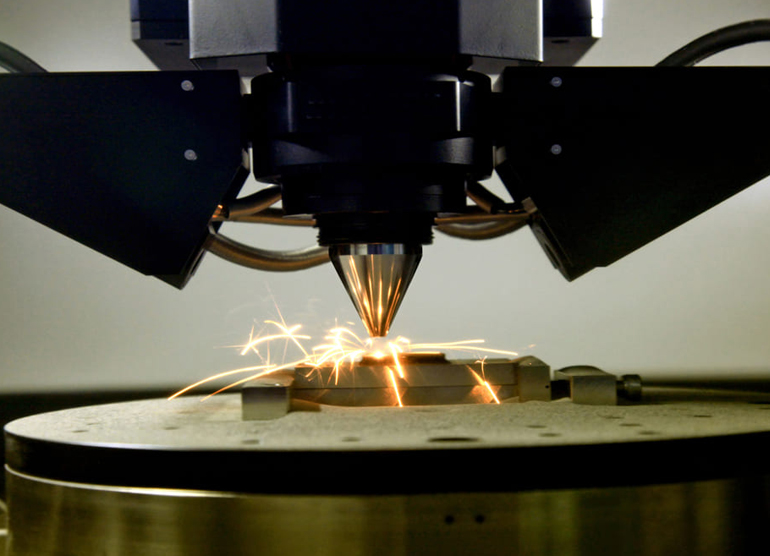
Blogs

Metal additive manufacturing techniques offer advantages over traditional methods such as CNC
machining or injection molding. One of the benefits is the reduction of material waste, which is especially important when employing expensive metals like copper or precious metals. Metal 3D
printing only consumes the material required to make a part, with the support structures producing very little waste.
Additionally, as 3D printing opens up intricate geometrical design possibilities, it's feasible to optimize part topology, density, and weight, which contributes to even greater cost savings for metal 3D printing materials.
Let's look at some of the most popular metal 3D printing materials.
- Maraging steel (Tool steel)
The high amounts of alloying required to offer a combination of high tensile strength and good fracture toughness make maraging steel highly expensive. Maraging steel has a high damage tolerance and one of the highest strength-to-weight ratios. Maraging steel offers exceptional mechanical qualities and is easily heat-treatable to produce superior hardness and tensile strength.
This makes the material perfect for various tooling applications, including injection molding tools, cores, die-casting inserts, and punch pressing, as well as for highly engineered parts for heavy-duty applications in the aerospace and automotive industries.
In Direct Metal Laser Sintering (DMLS), Fused Filament Fabrication (FFF) techniques, Maraging steel alloys like MS1, 18Ni1400, 18Ni1700, 18Ni1900, 18Ni2400, and 17Ni1600 (cast) are used in Powder or filament form.
- Stainless steel
It is well known that stainless steel is a less expensive option than titanium or nickel. Stainless steel is now widely used in the aerospace, oil and gas, food service, and healthcare industries because of its superior hardness and toughness, outstanding corrosion resistance, exceptional weldability, and extremely ductile characteristics.
Alloys like 316L and 17-4PH are frequently used in powder and filament forms in 3D printing Binder Jetting, Direct Metal Laser Sintering (DMLS), and Direct Metal Deposition (DMD).
- Titanium
Titanium is an amazing material for harsh environments in the automotive, aviation, and medical/dental sectors due to its outstanding biocompatibility, strength, durability, strong corrosion resistance, and good density.
Typical alloys like Ti6Al4V and Ti64 are used in powder, and filament form in Direct Energy Deposition (DED), Electron Beam Melting (EBM), Selective Laser Melting (SLM), and Fused Filament Fabrication (FFF).
- Aluminum
The automobile and aerospace sectors get more benefits from aluminum. It is mainly used to create lightweight, geometrically complicated parts required for these industries. The best strength-to-weight ratio, along with excellent chemical and corrosion resistance, makes aluminum perfect for manufacturing and post-processing resistance to high temperatures and thermal and electrical conductivity.
Alloys like Scalmalloy, ALSi7Mg, AlSi7Mg0, Al 6061 and Al 7075, and AU4G1 are frequently used in powder or filament forms in Laser powder bed fusion (LPBF), Electron Beam Powder Bed Fusion, Binder Jetting, and more rarely in Fused Deposition Modeling (FDM).
- Cobalt chromium alloy
Cobalt chromium alloy is mostly used in medical devices like surgical and dental implants. Perfect biocompatibility, high strength, high-temperature resistance, and non-magnetic are all characteristics of the cobalt-chromium alloy, which makes it an excellent material for medicinal applications. Common alloys include CoCrMo, used in Direct Metal Laser Sintering (DMLS) in powder form.
- Nickel alloys
Nickel is a highly adaptable substance that can alloy with a wide variety of other metals. Nickel alloys are used in various industries, including aerospace, chemical processing, and shipbuilding, and are ideal for 3D printing applications.
They can be used in turbine power plants, highly critical nuclear power systems, and jet engine gas turbine blades due to their considerable corrosion resistance in harsh environments and great durability at high temperatures. Parts manufactured of nickel alloys also offer good fracture resistance and tensile strength.
Some common alloys are Inconel 625, Inconel 713, Inconel 718, Inconel 738, Inconel 939, Hastelloy X, Haynes 282, and Amperprint alloy 625 and 718, which are used in powder and filament form for Direct Metal Laser Sintering (DMLS), Selective Laser Melting (SLM), and Fused Filament Fabrication (FFF).
- Precious metals
Precious metals allow high levels of design freedom. 3D printing of precious metals is perfect for jewelry, watches, dentistry (crowns, inlays, and onlays), and electronics. The majority of precious metals have significant heat conductivity and reflectivity. A homogeneous part cannot be created by conventional AM laser-based printers because the ingredients cannot be completely melted. Few manufacturers have created 3D printers that are effective enough to use Direct Metal Laser Sintering (DMLS) or Material Jetting to process these precious metal materials.
Gold, Silver, and Platinum have often been used metals in Powder forms in Direct Metal Laser Sintering (DMLS) and Material Jetting.
Metal 3D printing technologies and methods have grown as a result of the efforts of various manufacturers around the world. As a result, new materials are becoming accessible to fulfill the unique requirements of many sectors. Metal additive manufacturing offers creative solutions where conventional subtractive production is restricted in the automobile, aircraft, nuclear safety, and medical industries.
Choose the Best 3D Printing Material for your next Project with Innovae3D.
Innovae3D- Bringing Ideas to Life
Innovae3D is a leading Metal Additive Manufacturing company specializing in 3D Metal printing in India, 3D Scanning, CNC machining services, Conformal Cooling Tooling Services, Direct Metal Laser Sintering, and Rapid Prototyping Services in India. We help you overcome your product development and research and development problems by offering a one-stop shop for additive manufacturing.